Profession - trumpeter. Tool
→ 1 part
After getting acquainted with the features of our work, it is time to talk about the most important thing - the tool. Strangely enough, but many people think that the pipe is a generic name for wind. They include the saxophone, and trombone, and that only do not carry. Under the cut, I want to clarify the technical part of our work, and introduce you to various subjects that make life easier for a musician.
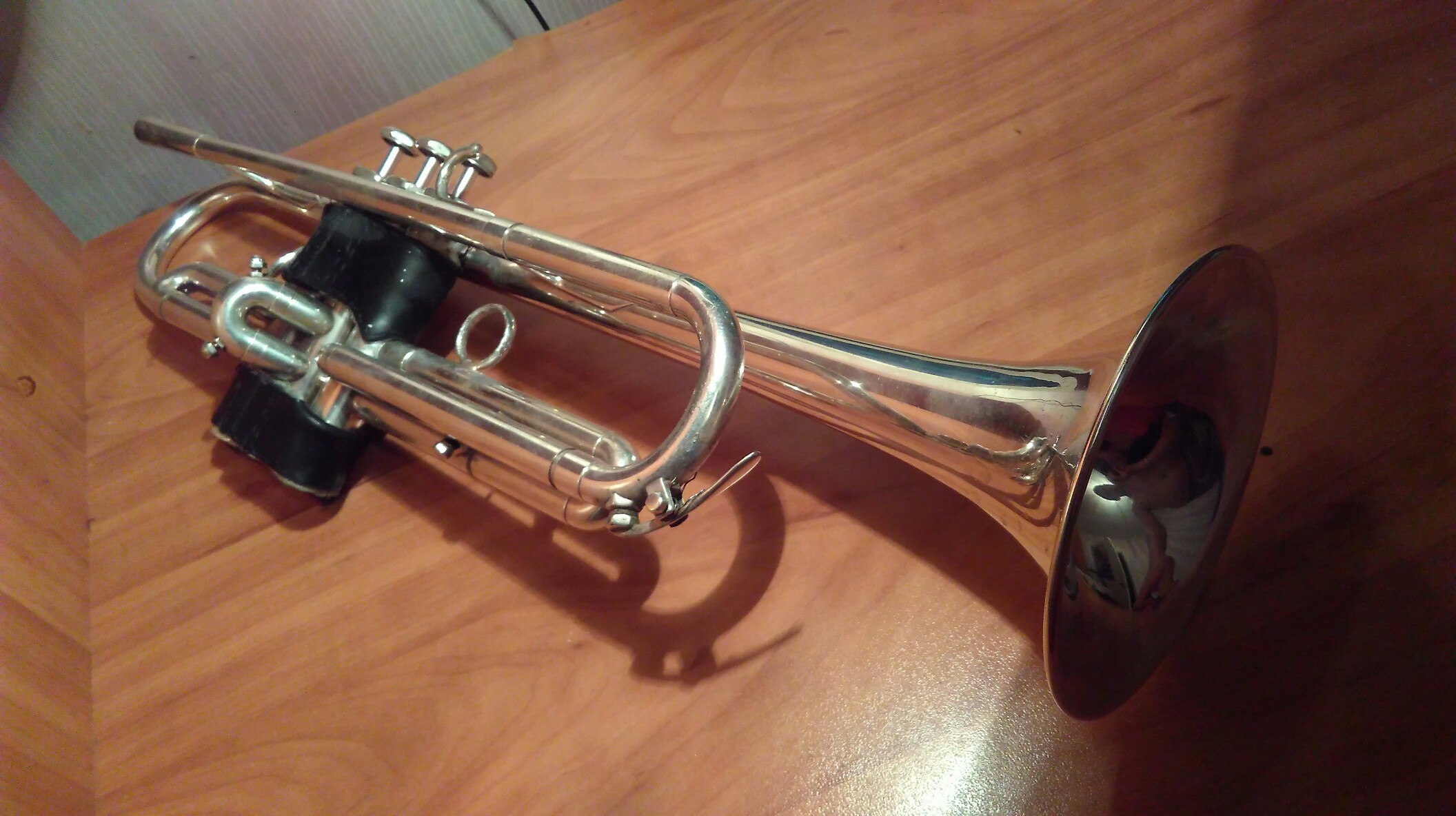
My pipe Firm Shilke, model B5. Chicago manufacturing. Semi-professional.
At this point I want to complete my small review of the technical part of our work. In the next article I want to tell in detail the history of the evolution of the instrument, for which it is very interesting to observe, and about how and with whom the flowering of trumpet music occurred.
After getting acquainted with the features of our work, it is time to talk about the most important thing - the tool. Strangely enough, but many people think that the pipe is a generic name for wind. They include the saxophone, and trombone, and that only do not carry. Under the cut, I want to clarify the technical part of our work, and introduce you to various subjects that make life easier for a musician.

My pipe Firm Shilke, model B5. Chicago manufacturing. Semi-professional.
Device

This is a natural pipe. On it you can well consider the main body without a machine.
Source: muswiki.ru/instruments/Natural_trumpet
')
It is made of metal or less often of plastic, which resonates at a certain frequency. The generally accepted standard for pipe is the sound of a B flat small octave. That is why the instrument is called “pipe B” or “sib”. There are also other types: C, Es, D, G, F, etc., but they are used much less frequently.

Natural overtone row of pipe sib. The first overtone is “dead” - it is almost not played. Mainly used range from 2 to 8-9. And yes, I have chromatism. This is 11 - 12 overtone and above.
Let's call it that, explain why. As presented above, a highly limited number of sounds can be extracted on a natural instrument. To overcome this problem, several mechanisms have been developed. With their help, you can extend the main air column by lowering the oscillation frequency. This gives us a sequence of overtones from another sound. By extending the instrument to a sufficient degree, and making it possible to combine different variants, we get a fully chromatic instrument.
There are 3 main systems:
1. Valve or piston. Like on my pipe. Mechanics like a piston and cylinder. In the unpressed state, the holes in the piston provide direct air flow, and when pressed, wrap it in an additional tube.

2. Rotary. These include: horn, tuba, baritone, rotor tubes. The concept is similar to the valve, but here instead of the “down-up” stroke, the rotor rotates axially. This provides a smaller stroke and a smaller system size. But in speed, she loses the valve, see due to several transmission elements and greater friction. Also, usually the rotor system uses not 3, but 4 or more tubes, which is connected with the feature of the structure of the instruments and the working range.

Source: http: //www.codamusic.ru/category.aspx? Category = 7130
3. Kulisnaya. Trombone, drawstring pipes. It uses two tubes, one inside the other. Extending the outside, we increase the total length of the air column => the sound decreases. The speed of this type is the lowest, there are difficulties with accurate transitions from sound to sound, since everything is advanced by sight and hearing. But you can do steep porches and glissando. The design is very simple, which was finally formed at the time of the Baroque.
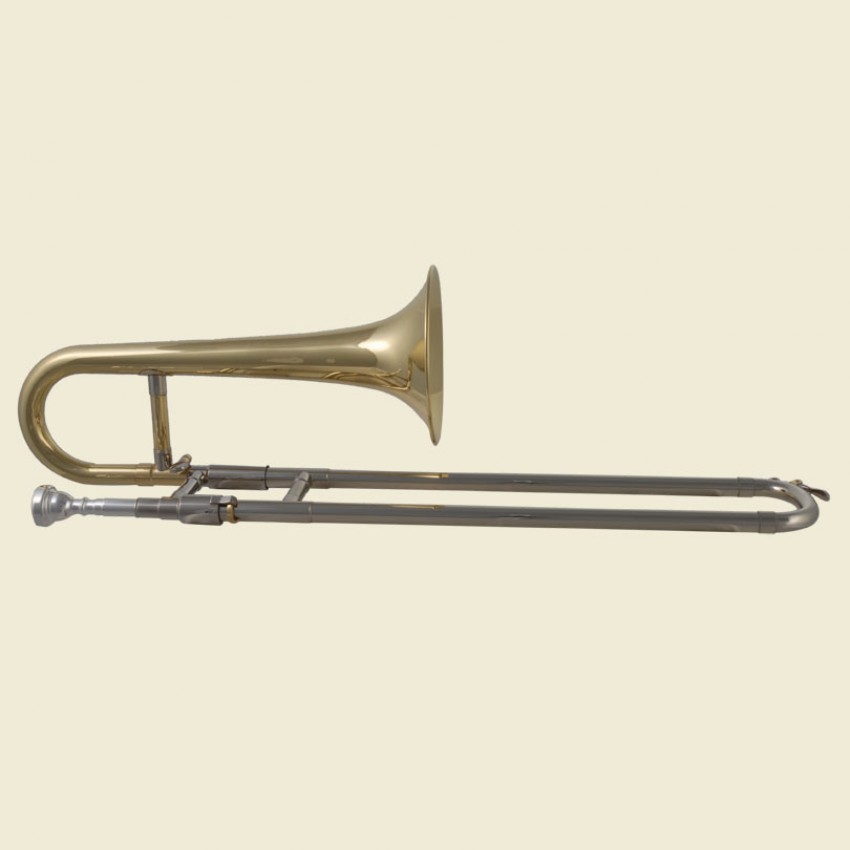
Source: totalbrass.de/index.php/tst-171-slide-trumpet-soprano-trombone.html
There were also valve instruments with the same system as that of woodwinds, but they did not take root.

For playing on the street, a plastic mouthpiece is used, if it is available of course. The sound is so-so, but lips do not freeze
Performs the function of a pickup. Accepts vibrations, focuses and redirects them to the main resonator. The device is very individual. No not like this. Very individual . This is due to the fact that each person's lips are different, and the performer is looking for something that suits him in terms of convenience and sound.
The main parameters are the depth of the cup and the inner diameter, the pitch of which can be 0.05 mm. And interestingly, this slight difference can be felt.
By choosing a mouthpiece musicians are very sensitive. Almost never take "blindly", be sure to try. And preferably the one that buy. If it is easier in the European part of Russia, then the appearance of a new mouthpiece is the whole event. Be sure all the familiar musicians will beg you to play it, discuss the characteristics, sound. Someone wants the same, someone will buy your old one. Such a small shake-up and rearrangement in the quiet life of musicians.
The strings of the guitar oscillate, the cane of the tree, and the lips themselves oscillate. This is called buzzing .
Instructions for picking up: say the syllable “em”. Inhale with your nose. You exhale into the center of the closed lips, almost as if whistling. Strengthen the air flow until the lips begin to vibrate. If it does not work, then either the lips are tightly compressed, or the air flow is insufficient.
Ways to explain the mass. Each of us is an artist, he sees and feels in his own way, so I would not be surprised if some of you have heard other instructions.
For fun, we inserted into the mouthpiece of a tuba (bass) an oboe cane and a whistle from a toy. The sounds were simply enchanting! A huge low instrumentscreamed like a girl shimmering overtones, going into low depths and flew up to the border with ultrasound!
About lips you can still add that they are tired. These are muscles which carry out extremely unusual loading - constrain the escaping air stream. And the bigger and stronger this flow, the faster they run out of steam. There are many sets of exercises aimed at strengthening the lip apparatus, developing its flexibility, strength and endurance. Specifically, I will continue to talk about this in the training part.
Housing

This is a natural pipe. On it you can well consider the main body without a machine.
Source: muswiki.ru/instruments/Natural_trumpet
')
It is made of metal or less often of plastic, which resonates at a certain frequency. The generally accepted standard for pipe is the sound of a B flat small octave. That is why the instrument is called “pipe B” or “sib”. There are also other types: C, Es, D, G, F, etc., but they are used much less frequently.

Natural overtone row of pipe sib. The first overtone is “dead” - it is almost not played. Mainly used range from 2 to 8-9. And yes, I have chromatism. This is 11 - 12 overtone and above.
System for chromatization tool
Let's call it that, explain why. As presented above, a highly limited number of sounds can be extracted on a natural instrument. To overcome this problem, several mechanisms have been developed. With their help, you can extend the main air column by lowering the oscillation frequency. This gives us a sequence of overtones from another sound. By extending the instrument to a sufficient degree, and making it possible to combine different variants, we get a fully chromatic instrument.
There are 3 main systems:
1. Valve or piston. Like on my pipe. Mechanics like a piston and cylinder. In the unpressed state, the holes in the piston provide direct air flow, and when pressed, wrap it in an additional tube.

2. Rotary. These include: horn, tuba, baritone, rotor tubes. The concept is similar to the valve, but here instead of the “down-up” stroke, the rotor rotates axially. This provides a smaller stroke and a smaller system size. But in speed, she loses the valve, see due to several transmission elements and greater friction. Also, usually the rotor system uses not 3, but 4 or more tubes, which is connected with the feature of the structure of the instruments and the working range.

Source: http: //www.codamusic.ru/category.aspx? Category = 7130
3. Kulisnaya. Trombone, drawstring pipes. It uses two tubes, one inside the other. Extending the outside, we increase the total length of the air column => the sound decreases. The speed of this type is the lowest, there are difficulties with accurate transitions from sound to sound, since everything is advanced by sight and hearing. But you can do steep porches and glissando. The design is very simple, which was finally formed at the time of the Baroque.

Source: totalbrass.de/index.php/tst-171-slide-trumpet-soprano-trombone.html
There were also valve instruments with the same system as that of woodwinds, but they did not take root.
Mouthpiece

For playing on the street, a plastic mouthpiece is used, if it is available of course. The sound is so-so, but lips do not freeze
Performs the function of a pickup. Accepts vibrations, focuses and redirects them to the main resonator. The device is very individual. No not like this. Very individual . This is due to the fact that each person's lips are different, and the performer is looking for something that suits him in terms of convenience and sound.
The main parameters are the depth of the cup and the inner diameter, the pitch of which can be 0.05 mm. And interestingly, this slight difference can be felt.
By choosing a mouthpiece musicians are very sensitive. Almost never take "blindly", be sure to try. And preferably the one that buy. If it is easier in the European part of Russia, then the appearance of a new mouthpiece is the whole event. Be sure all the familiar musicians will beg you to play it, discuss the characteristics, sound. Someone wants the same, someone will buy your old one. Such a small shake-up and rearrangement in the quiet life of musicians.
Sound source
The strings of the guitar oscillate, the cane of the tree, and the lips themselves oscillate. This is called buzzing .
Instructions for picking up: say the syllable “em”. Inhale with your nose. You exhale into the center of the closed lips, almost as if whistling. Strengthen the air flow until the lips begin to vibrate. If it does not work, then either the lips are tightly compressed, or the air flow is insufficient.
Ways to explain the mass. Each of us is an artist, he sees and feels in his own way, so I would not be surprised if some of you have heard other instructions.
For fun, we inserted into the mouthpiece of a tuba (bass) an oboe cane and a whistle from a toy. The sounds were simply enchanting! A huge low instrument
About lips you can still add that they are tired. These are muscles which carry out extremely unusual loading - constrain the escaping air stream. And the bigger and stronger this flow, the faster they run out of steam. There are many sets of exercises aimed at strengthening the lip apparatus, developing its flexibility, strength and endurance. Specifically, I will continue to talk about this in the training part.
Useful stuff
In a music school, I was little acquainted with the need to take care of an instrument. And arriving in the city, I was surprised at the variety of various items that allow you to improve and maintain the technical characteristics of your instrument.
Oil for caps
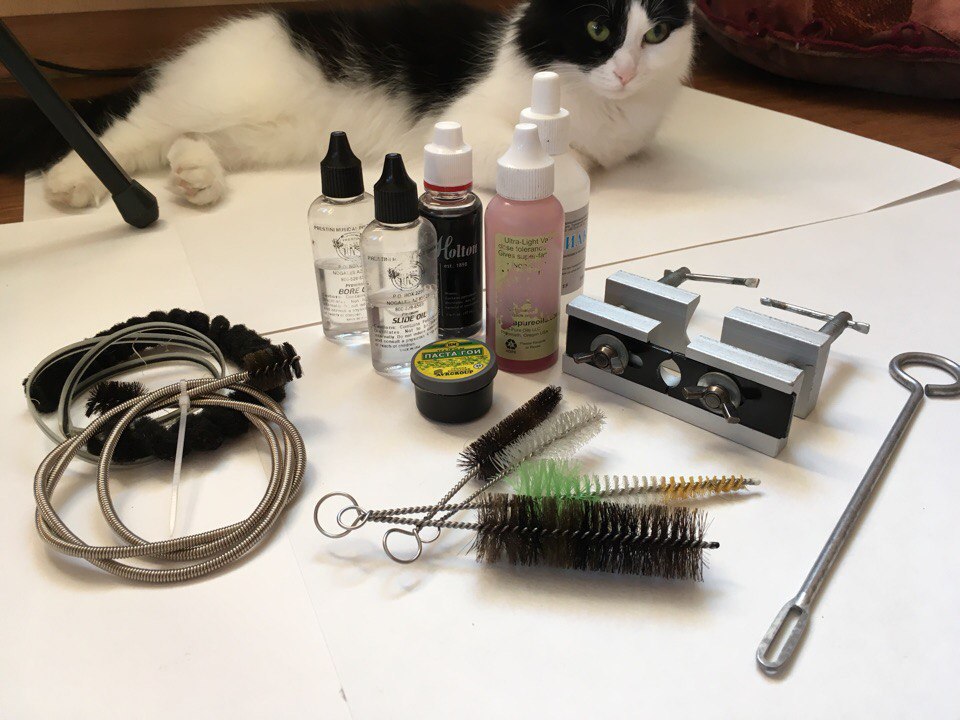
Junk does not happen much
As I said earlier, the piston resembles a piston and cylinder. In order not to regularly pull metal chips out of the valve, a line of oils has been developed. They are the same as for the car, only very cleaned and free from odors. I use 2 types of synthetic oils from an American company. One for regular lubrication, and the second for the concert. The latter provides high speed, but very quickly washed out.
Thick oil for crowns
Crowns are used to adjust the pitch, like pegs on the guitar. The main crown is greased with thick oil so that it does not dry out for a long time and does not fall out during rehearsal, like in some comrades. And the trim, small crowns, which depart from the caps, are lubricated with liquid so that you can easily move during the game.
I use thick red oil, which is originally lubricated with a cork at the mouthpiece of woodwind. But oddly enough, neither clarinetists, nor saxophonists appreciated it, but all the coppersmiths simply fell in love with this red sticky substance.
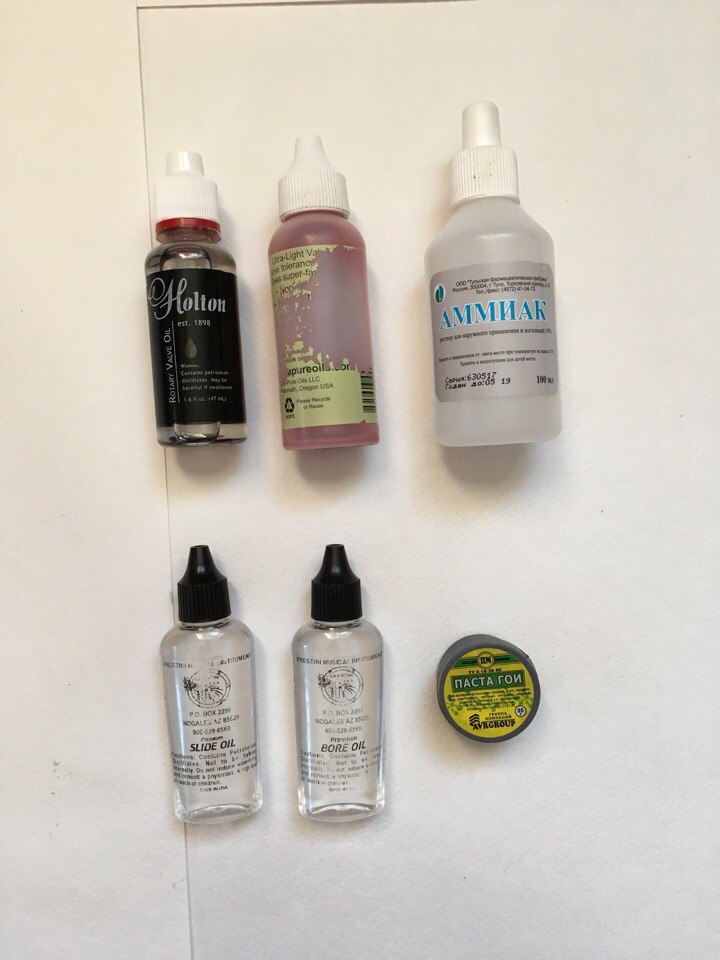
Yes, this life-beaten bank in the center is a saving grease. The original box burst, I had to pour it.
Brushes
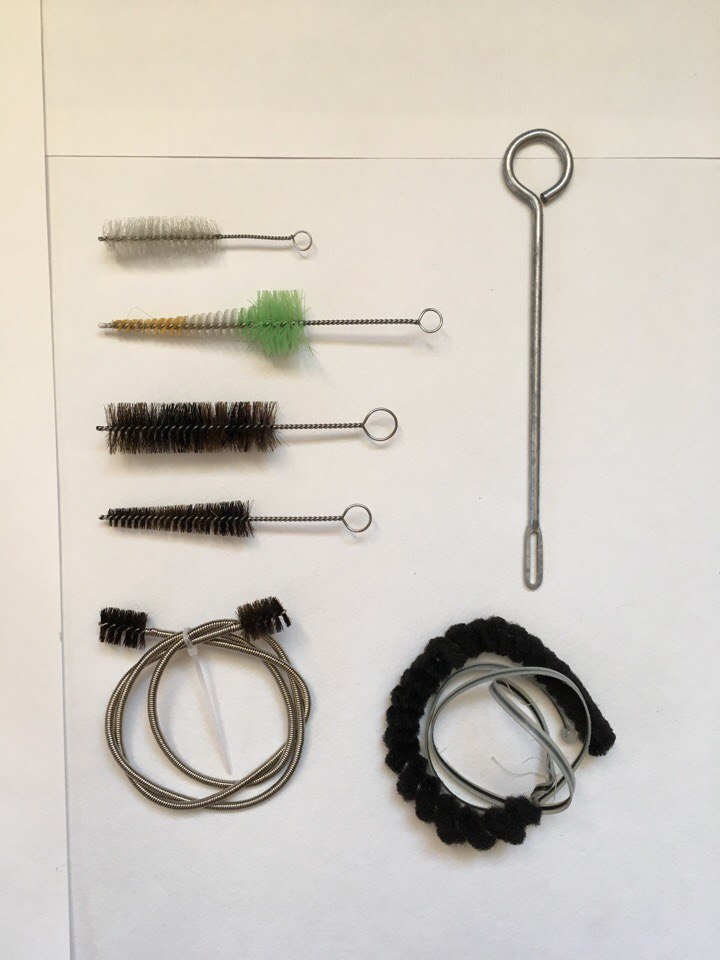
I have a whole set of them for different needs: for a mouthpiece, for caps, for the pipe itself. They are needed in order to remove various deposits from the inner walls of the instrument. Breakfast deposits, for example. Brr, an unpleasant sight, clean it up. Especially for a stranger.
In general, there previously existed, and even now exists, a whole cult of the fact that the instrument can be “inflated”. It is done this way: You take a new pipe. She is supposedly “unbreakable,” sounds bad. Doing it. And after a month or two, its properties magically change. There is a growing layer of sediment, in which the air cuts the channel , giving you your unique timbre. And in no case can the tune be cleaned. There are still adherents who are trying to convince me that the air is cutting metal threads . Then he laughed heartily. I don’t argue that this technology may exist in industry, but it is not subject to the human lungs.
If you analyze this process from the physical and psychological side, it is clear that a person just gets used to the instrument, knows its acoustics. And all the mucus on the walls only hinders and dampens vibrations.
By the way, a “blow out” tool is possible. If it is not cleaned for a long time, then everything inside is clogged, closes the channel, and the pipe stops playing. It is easily treated with a warm soap bath, shower jet and a brush.
Pipe stand
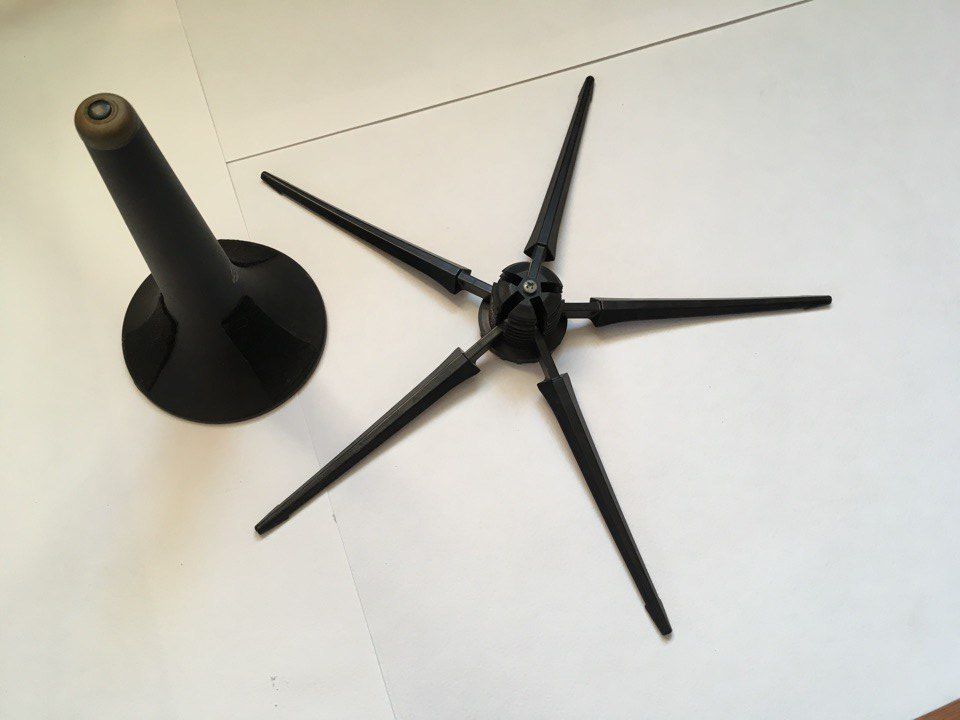
Disassembled, this item raises more questions.
For an orchestral rehearsal with countless pauses, the thing is simply irreplaceable. So you had to keep all the watches in your hand.
In the theater there was a case when one of my colleagues, already aged, fell asleep from long pauses. Put the pipe on the stand, sit, wait, and slowly under classical music plunges into the realm of Morpheus. But as soon as through a dream he hears a motive that foreshadows his entry, in the blink of an eye his eyes open wide, his hand rips the instrument off the stand with a sharp movement, and brings it to his lips! All it takes is a split second. Then the situation was unfolding in two ways: either we quickly show where we are playing, or just as quickly we pull our colleague away from a false start.
Pencil holder
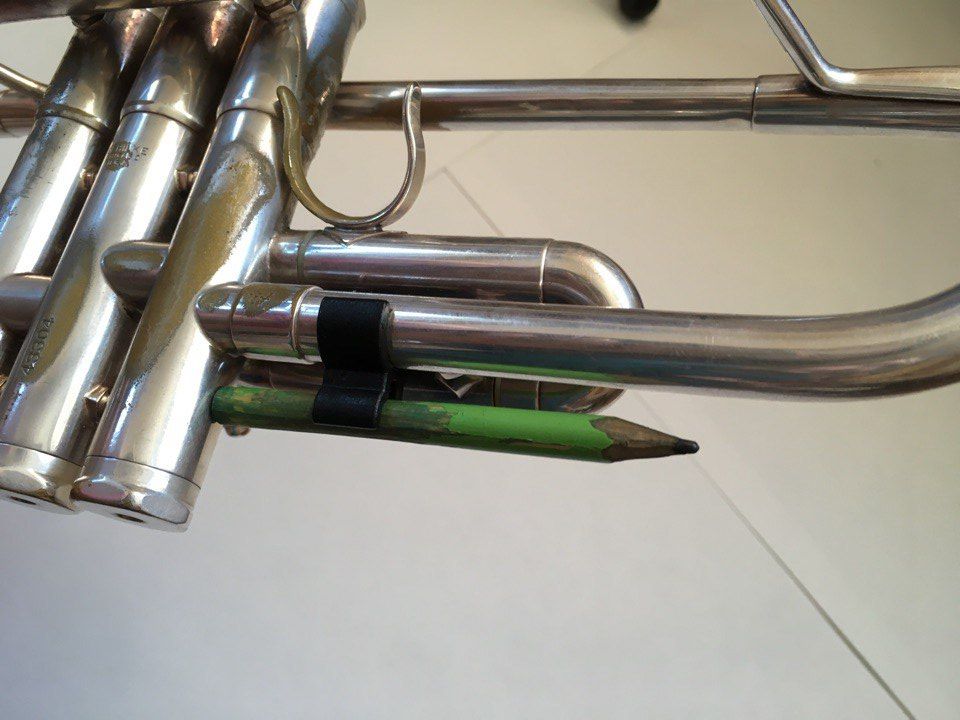
Incredibly convenient device for storing a pencil on the tool itself. Always at hand.
Savior named "S"
There are such situations that you sit in the classroom, your pipe lies nearby. Everything is as usual. You want to work out, drag your hand and ... Awkward movement, and your instrument for dozens, or even hundreds of thousands of flies on the floor. Time stands still ...
All the played pieces, all the specks that you wiped off, and all the time you spent together, rush before your eyes. Your hand rushes after, trying to grasp the falling creation, but your fingers pierce the void. Your friend, seeing this, screams and, in a jump, tries to save from the inevitable. But it's too late ... a dull thump. Behind him another more sonorous. With a sinking heart and trembling in your hands, you lift the pipe, examine it. Lucky. The blow fell on the mouthpiece and the rigid ring of the bell. Nothing is crumpled. Everything is really fine.
The problem will be revealed a little later. The mouthpiece itself and the tube where it is inserted are made from copper alloys. In order to hold it, the friction force of the cone-shaped joint is used. And if the blow fell on the mouthpiece, directed deep into the pipe, then, as you can already guess, just because it is now not pull out. You can try to knock out something wooden, but there is a more humane way.
Ta-dam! Mouthpiece puller

Savior, who at such moments wants to offer up odes. Yes, this is the most common puller for conical connections.
Lotions, brushes and oils
In a music school, I was little acquainted with the need to take care of an instrument. And arriving in the city, I was surprised at the variety of various items that allow you to improve and maintain the technical characteristics of your instrument.
Oil for caps

Junk does not happen much
As I said earlier, the piston resembles a piston and cylinder. In order not to regularly pull metal chips out of the valve, a line of oils has been developed. They are the same as for the car, only very cleaned and free from odors. I use 2 types of synthetic oils from an American company. One for regular lubrication, and the second for the concert. The latter provides high speed, but very quickly washed out.
Thick oil for crowns
Crowns are used to adjust the pitch, like pegs on the guitar. The main crown is greased with thick oil so that it does not dry out for a long time and does not fall out during rehearsal, like in some comrades. And the trim, small crowns, which depart from the caps, are lubricated with liquid so that you can easily move during the game.
I use thick red oil, which is originally lubricated with a cork at the mouthpiece of woodwind. But oddly enough, neither clarinetists, nor saxophonists appreciated it, but all the coppersmiths simply fell in love with this red sticky substance.

Yes, this life-beaten bank in the center is a saving grease. The original box burst, I had to pour it.
Brushes

I have a whole set of them for different needs: for a mouthpiece, for caps, for the pipe itself. They are needed in order to remove various deposits from the inner walls of the instrument. Breakfast deposits, for example. Brr, an unpleasant sight, clean it up. Especially for a stranger.
In general, there previously existed, and even now exists, a whole cult of the fact that the instrument can be “inflated”. It is done this way: You take a new pipe. She is supposedly “unbreakable,” sounds bad. Doing it. And after a month or two, its properties magically change. There is a growing layer of sediment, in which the air cuts the channel , giving you your unique timbre. And in no case can the tune be cleaned. There are still adherents who are trying to convince me that the air is cutting metal threads . Then he laughed heartily. I don’t argue that this technology may exist in industry, but it is not subject to the human lungs.
If you analyze this process from the physical and psychological side, it is clear that a person just gets used to the instrument, knows its acoustics. And all the mucus on the walls only hinders and dampens vibrations.
By the way, a “blow out” tool is possible. If it is not cleaned for a long time, then everything inside is clogged, closes the channel, and the pipe stops playing. It is easily treated with a warm soap bath, shower jet and a brush.
From the cycle “How could I live without it before?”
Pipe stand

Disassembled, this item raises more questions.
For an orchestral rehearsal with countless pauses, the thing is simply irreplaceable. So you had to keep all the watches in your hand.
In the theater there was a case when one of my colleagues, already aged, fell asleep from long pauses. Put the pipe on the stand, sit, wait, and slowly under classical music plunges into the realm of Morpheus. But as soon as through a dream he hears a motive that foreshadows his entry, in the blink of an eye his eyes open wide, his hand rips the instrument off the stand with a sharp movement, and brings it to his lips! All it takes is a split second. Then the situation was unfolding in two ways: either we quickly show where we are playing, or just as quickly we pull our colleague away from a false start.
Pencil holder

Incredibly convenient device for storing a pencil on the tool itself. Always at hand.
Savior named "S"
There are such situations that you sit in the classroom, your pipe lies nearby. Everything is as usual. You want to work out, drag your hand and ... Awkward movement, and your instrument for dozens, or even hundreds of thousands of flies on the floor. Time stands still ...
All the played pieces, all the specks that you wiped off, and all the time you spent together, rush before your eyes. Your hand rushes after, trying to grasp the falling creation, but your fingers pierce the void. Your friend, seeing this, screams and, in a jump, tries to save from the inevitable. But it's too late ... a dull thump. Behind him another more sonorous. With a sinking heart and trembling in your hands, you lift the pipe, examine it. Lucky. The blow fell on the mouthpiece and the rigid ring of the bell. Nothing is crumpled. Everything is really fine.
The problem will be revealed a little later. The mouthpiece itself and the tube where it is inserted are made from copper alloys. In order to hold it, the friction force of the cone-shaped joint is used. And if the blow fell on the mouthpiece, directed deep into the pipe, then, as you can already guess, just because it is now not pull out. You can try to knock out something wooden, but there is a more humane way.
Ta-dam! Mouthpiece puller

Savior, who at such moments wants to offer up odes. Yes, this is the most common puller for conical connections.
At this point I want to complete my small review of the technical part of our work. In the next article I want to tell in detail the history of the evolution of the instrument, for which it is very interesting to observe, and about how and with whom the flowering of trumpet music occurred.
Source: https://habr.com/ru/post/371215/
All Articles